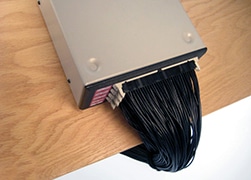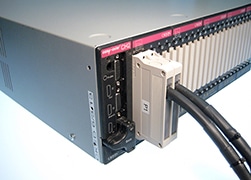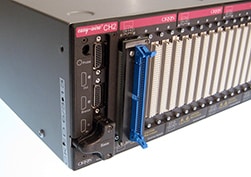What is the Most Cost-effective Way to Back-wire a Harness Board?
When it comes to wire harnesses built on form boards, one of the biggest challenges is: “Where do you test?” Most harness manufacturers would like to test on the form board itself, but this can be costly and complex.
Based on years of experience selling cable and harness testers, Cirris has developed products to help customers adapt their Cirris testers to allow them to test on their form boards.
This article gives examples of some ways you can approach “On-The-Board” harness testing for back-wired harness boards. There are literally as many different processes for building and testing wire harnesses as there are shops building them.
1. A dedicated harness board with dedicated tester

Dedicated CR Tester (CCRW-BU) mounted on back side of harness board
When volume or complexity justifies it, customers will often dedicate a tester to a single form board. In this case, the lowest cost solution is to wire directly to the tester without using any kind of transition board or intermediary connector. This direct-connect solution is usually reserved for build-boards that stay on the floor full-time. This is because dangling wires make board storage more difficult (and can result in damage when boards are retrieved) and they add cost (you must duplicate the wiring between tester and harness board for each board built.) Often customers mount their tester directly on the harness board.
2a. A station where a tester is dedicated and harness boards are moved in and out, OR; A station where a harness board is dedicated and testers are moved in and out
In both of these scenarios, back-wired harness boards are plugged into testers for electrical testing. This may occur once the harness is built (for final electrical test only) or during the entire harness fabrication (when guided assembly and testing is being used). In these cases, the preferred solution is to use transition boards that are permanently mounted to the form board. These transition boards allow customers to quickly connect/disconnect the tester at the transition board. The back wiring goes only to the transition boards, which means there are no dangling wires. This reduces the risk of damage when moving these boards to and from storage. Cirris offers 64-pin transition boards which allow an easy transition of 64-pin ribbon cables from the tester to 64-pin discrete wires on the harness board. For those who prefer, discrete wired cables can be used in lieu of ribbon cables (we also have 32-pin high voltage transition boards if more than 1500V are needed).


CR Tester (CCRW-BU) connected to Screw Transition Board (ETB-ST) with Ribbon Connector (AC22-64)


CH2 Tester (CCH2-BU) with CR Converter (ACH2-CR) connected to Screw Transition Board (ETB-ST) with Ribbon Connector (AC22-64)
2b. A low voltage guided-build combined with a high voltage final test on the same board
If harness boards are already back-wired for a final electrical test, you might consider dedicating low-cost, low voltage testers to each build-board for guided assembly. In most cases, throughput improvements easily justify this investment. Since assemblers are “testing as they build,” they won’t build them incorrectly. When assembly is complete, the low-voltage tester is unplugged and portable high voltage testers are plugged in to do final electrical test (IR/DWV). Generally, for testing up to 1500VDC, the 64-pin transition boards are used. Customers convert the CH2’s 32-pin VME connectors to match the CR’s 64-pin headers using the CH to CR adapter. They also upgrade from ribbon cables to discrete wire cable for improved performance. Easy transitions from low voltage to high voltage testing allows customers to build, test, and perform final high voltage electrical testing all on the same form board, the goal being to take the harness from the form board straight to the shipping box.


CH2 Tester (CCH2-BU) with CR Converter (ACH2-CR) connected to Screw Transition Board (ETB-ST) with Discrete Wire Connector (ADX2-64)


CH2 Tester (CCH2-BU) connected to VME Transition Board (ETB-SHV) with CH2 VME Connector (AC62-KF)
3. Plugging/unplugging of connectors at the tester instead of at the harness board
In some cases customers want the “break point” at the tester face instead of at the harness board (this is always the case in scenario #1, since the wiring goes straight from the harness connectors to the tester’s connectors). Listed below are a number of reasons for wanting a different connector at the tester:
- Quickly plugging/unplugging high pin-count connectors
Customers with very high pin-count connectors may find the 32 or 64-pin transition boards limiting when plugging/unplugging testers into the harness board. In this case, higher pin-count connectors at the face of the tester may be chosen. - Ease of plugging/unplugging (ZIF connectors)
Customers who plug/unplug frequently (switching between low voltage guided-build and high voltage final test, for example) sometimes want a Zero Insertion Force (ZIF) connector, such as the DL-156. - Connector wear issues (cycle count)
Also, when customers plug/unplug their connectors frequently, connector wear becomes a concern. To remedy this issue, Cirris offers a Connector Saver that customers may attach to the face of the CH2 tester. Also, for those switching between low voltage and high voltage testing, the “CH to CR adapter” is an inexpensive option and is easily replaced when worn out. Again, some customers choose a ZIF type connector, so replacement is not required. - Legacy issues
In many cases, customers who are upgrading their testers want to keep using their legacy interface wiring. To help with this, we have delivered many testers with various “adapter panel” front end interfaces to accommodate the customer’s connector of choice


CH2 Tester with Custom ZIF Connector and InterfaceCH2 Connector Saver/Quick Connect (ADCS-C2)

CH2 Tester with CR Converter (ACH2-CR)

